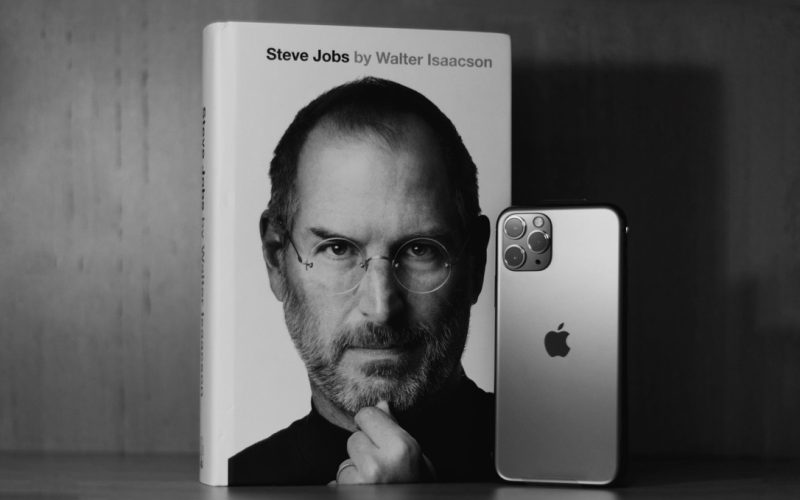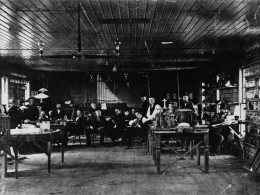Table of Contents Show
I. The Seed of Innovation: A Turbulent Early Life
Steve Jobs was born on February 24, 1955, in San Francisco, California, to Abdulfattah Jandali and Joanne Schieble, two young graduate students who found themselves unable to care for a child. Jobs was adopted at birth by Paul and Clara Jobs, a working-class couple who lived in Mountain View, in the heart of what would later become Silicon Valley. From the very beginning, Jobs’ life was marked by a sense of displacement and restlessness. Though he was loved and cared for by his adoptive parents, the knowledge that he had been given up at birth left an indelible mark on his psyche, fueling a drive to prove his worth to the world.
The Jobs household was one where hard work and frugality were valued above all else. Paul Jobs, a machinist, taught young Steve the importance of craftsmanship, instilling in him an appreciation for well-made tools and machines. These lessons would later become a cornerstone of Jobs’ design philosophy. However, the classroom environment proved to be a source of frustration for Jobs, who was often bored and disruptive. He found little interest in the rigid structure of traditional schooling, preferring instead to explore the world on his own terms.
By the time he reached high school, Jobs had become deeply interested in electronics and technology, a passion that was fueled by his friendship with Steve Wozniak, an equally gifted young engineer. The two Steves, as they would come to be known, shared a fascination with the burgeoning world of computer technology. It was during this period that Jobs’ rebellious nature began to take shape. He questioned authority, challenged the status quo, and sought out experiences that were outside the mainstream. These traits, which often put him at odds with teachers and peers, would later define his approach to business and innovation.
Jobs briefly attended Reed College in Portland, Oregon, but dropped out after just one semester. Despite leaving formal education behind, he continued to audit classes, including a calligraphy course that would later influence the design of Apple’s first computer. Jobs spent the next few years searching for meaning and direction, traveling to India in pursuit of spiritual enlightenment and experimenting with alternative lifestyles. These experiences broadened his perspective, shaping his vision of how technology could intersect with art, culture, and the human experience.
The roots of Steve Jobs’ genius can be traced to this period of exploration and self-discovery. It was here, in the crossroads between counterculture and technology, that Jobs began to form the ideas that would later revolutionize the world. His early life was marked by a restless energy, a relentless drive to find his place in a world that often seemed out of sync with his ambitions. Yet, it was this very restlessness that would fuel his greatest achievements.
II. The Birth of Apple: Innovation Meets Ambition
In 1976, at the age of 21, Steve Jobs co-founded Apple Computer in the garage of his parents’ home in Los Altos, California, alongside his friend Steve Wozniak and a small group of collaborators. The company’s first product, the Apple I, was a simple circuit board that appealed mainly to hobbyists, but it was a beginning. What set Jobs apart was not just his technical acumen but his ability to see beyond the limitations of existing technology. He envisioned a future where computers were not just tools for engineers and scientists but accessible devices that could be used by ordinary people.
Jobs’ vision was fully realized with the release of the Apple II in 1977. Unlike its predecessor, the Apple II was a complete, ready-to-use system that came in a sleek, plastic case—a radical departure from the bare circuit boards of other computers at the time. The Apple II was an instant success, becoming one of the first highly successful mass-produced personal computers. Jobs, with his unerring sense of design and consumer needs, had tapped into a new market, one that saw computers not just as machines, but as gateways to a new world of possibilities.
But Jobs was not content to rest on his laurels. His sights were set even higher. In 1984, Apple introduced the Macintosh, the first personal computer to feature a graphical user interface and a mouse. The Macintosh was a bold leap forward, a product that combined cutting-edge technology with a user-friendly design. Its launch, with the iconic “1984” commercial directed by Ridley Scott, was a masterstroke of marketing, positioning the Macintosh as a symbol of creativity and individualism in the face of conformity.
Yet, the success of the Macintosh was not without its challenges. Inside Apple, tensions were rising. Jobs’ relentless pursuit of perfection, his exacting standards, and his often abrasive management style alienated many within the company. In 1985, following a power struggle with Apple’s board of directors, Jobs was ousted from the very company he had founded. It was a devastating blow, one that left him reeling. But Jobs, ever the visionary, saw it as an opportunity to start anew.
The birth of Apple was a testament to Steve Jobs’ ability to turn ideas into reality. It was a period marked by both extraordinary success and deep personal challenges. Jobs had transformed the way the world thought about technology, but his journey was far from over. The lessons he learned during this time—about leadership, innovation, and the power of vision—would shape the next chapter of his life.
III. The Wilderness Years: NeXT, Pixar, and the Long Road Back
After his departure from Apple, Steve Jobs entered what many would consider the wilderness years—a period marked by both failure and success, but one that was crucial to his later triumphs. In 1985, Jobs founded NeXT, a computer company aimed at the higher education and business markets. NeXT’s computers were technologically advanced, with features like object-oriented programming and a pioneering graphical user interface. However, the machines were expensive and failed to gain significant market traction.
NeXT was, in many ways, a reflection of Jobs’ unyielding commitment to innovation and quality. He poured his heart and soul into the company, ensuring that every detail of the product, from the hardware design to the software architecture, met his exacting standards. But despite his best efforts, NeXT struggled financially. The company’s products were admired for their technical prowess but criticized for their high cost and lack of a clear market. For Jobs, it was a humbling experience—a reminder that even the most brilliant ideas can fail without the right execution.
While NeXT was floundering, another of Jobs’ ventures was beginning to take off. In 1986, Jobs purchased a small computer graphics division from Lucasfilm, which he transformed into Pixar Animation Studios. Initially, Pixar was a struggling hardware company, but Jobs saw potential in its team of talented animators and their cutting-edge software. Under his leadership, Pixar shifted its focus to creating animated films, and in 1995, it released Toy Story, the world’s first feature-length computer-animated movie.
Toy Story was a monumental success, both critically and commercially, establishing Pixar as a major force in the entertainment industry. Jobs had not only helped to revolutionize the world of animation but had also redefined the business model of the film industry. Pixar’s success was a vindication for Jobs, who had faced years of skepticism and doubt. It also provided him with the financial resources and confidence to make a triumphant return to the company he had founded.
In 1996, Apple, struggling in Jobs’ absence, acquired NeXT for $429 million, bringing Jobs back into the fold. The acquisition was a turning point, both for Apple and for Jobs. The technology developed at NeXT became the foundation for macOS, the operating system that would power Apple’s future products. More importantly, Jobs’ return marked the beginning of a new era for Apple—one that would see the company rise from the brink of bankruptcy to become the most valuable corporation in the world.
The wilderness years were a time of reflection and reinvention for Steve Jobs. They were marked by setbacks and failures, but also by extraordinary successes. Jobs emerged from this period with a renewed sense of purpose and a deeper understanding of what it takes to build a lasting legacy. His experiences at NeXT and Pixar would inform his leadership at Apple, shaping the products and strategies that would define the next decade.
IV. The Second Coming: Revolutionizing the Digital World
When Steve Jobs returned to Apple in 1997, the company was on the verge of collapse. Its product lines were bloated, its finances were in disarray, and its brand had lost its luster. Jobs quickly set about transforming the company, slashing product lines, streamlining operations, and focusing on a few key areas where Apple could innovate. His leadership style, honed by years of experience, was now more tempered but no less demanding. Jobs was determined to restore Apple to its former glory—and he succeeded beyond anyone’s wildest expectations.
The first major product to emerge from this new era was the iMac, released in 1998. With its striking design and user-friendly features, the iMac was a commercial success, revitalizing Apple’s brand and putting the company back on the map. The iMac was just the beginning. Over the next decade, Jobs and his team would introduce a series of products that would revolutionize entire industries: the iPod in 2001, the iTunes Store in 2003, the iPhone in 2007, and the iPad in 2010.
Each of these products was a game-changer in its own right, but together, they represented something far more significant—a complete reimagining of the relationship between technology and the user. Jobs’ vision was to create products that were not only powerful and functional but also beautiful and intuitive. He believed that technology should be an extension of the user, seamlessly integrated into their lives. This philosophy was embodied in Apple’s approach to design, which prioritized simplicity, elegance, and ease of use.
The iPhone, in particular, was a culmination of Jobs’ vision. It was not just a phone; it was a pocket-sized computer, a digital hub that brought together all the elements of Apple’s ecosystem. The iPhone’s impact was immediate and profound, reshaping the telecommunications industry and setting the standard for smartphones. Jobs had once again changed the world, creating a product that would become an indispensable part of daily life for millions of people.
But the success of Apple’s products was not just about technology; it was also about the brand that Jobs had built. Apple, under Jobs’ leadership, became synonymous with innovation, quality, and style. The company’s marketing campaigns, product launches, and retail stores all reflected Jobs’ meticulous attention to detail and his understanding of the emotional connection between people and their devices. Jobs had transformed Apple into more than just a technology company—it was a cultural phenomenon.
The second coming of Steve Jobs at Apple was a period of unparalleled success and innovation. It was a time when Jobs fully realized his vision for the future of technology, creating products that would shape the digital age. Yet, even as he was achieving unprecedented success, Jobs was facing a personal battle that would soon come to define the final chapter of his life.
V. The Final Chapter: Legacy and Mortality
In 2003, Steve Jobs was diagnosed with a rare form of pancreatic cancer. True to his nature, Jobs initially chose to treat the illness with alternative therapies, delaying surgery for several months. This decision would later be the subject of much debate and speculation, but for Jobs, it was consistent with his lifelong belief in the power of intuition and alternative thinking. When he finally underwent surgery, the prognosis seemed hopeful, but the cancer would return, leading to a long and painful battle that would dominate the final years of his life.
Despite his illness, Jobs continued to work tirelessly, driving Apple to new heights. The years following his diagnosis saw the release of some of Apple’s most iconic products, including the iPhone and the iPad. Jobs remained deeply involved in every aspect of the company, from product design to marketing strategy, often pushing himself to the brink of exhaustion. His dedication to Apple was unwavering, even as his health deteriorated.
In August 2011, Jobs resigned as CEO of Apple, handing the reins to his trusted lieutenant, Tim Cook. It was a poignant moment, marking the end of an era. Jobs’ resignation letter was brief but powerful, expressing his confidence in Apple’s future and his deep gratitude for the opportunity to lead the company he had founded. Two months later, on October 5, 2011, Steve Jobs passed away at the age of 56, surrounded by his family.
Jobs’ death was met with an outpouring of grief and admiration from around the world. He was remembered not just as a brilliant innovator, but as a cultural icon—a man who had changed the way people live, work, and communicate. Tributes poured in from world leaders, industry giants, and ordinary people whose lives had been touched by Jobs’ creations. His legacy was secure, not just in the products he had helped to create, but in the profound impact he had on the world.
Steve Jobs’ life was a story of triumph and tragedy, of extraordinary achievements and deep personal struggles. He was a man who defied convention, who saw the world not as it was, but as it could be. Jobs’ legacy is not just the technology he created, but the vision and passion that drove him. He was a true architect of the digital age, a man whose ideas and innovations will continue to shape the world for generations to come.
In the end, Steve Jobs was more than just a CEO or an inventor—he was a visionary, a dreamer, and a relentless pursuer of excellence. His life was a testament to the power of imagination and the importance of following one’s own path, no matter how unconventional. Jobs’ story is a reminder that greatness often comes at a price, but that the rewards—both for the individual and for the world—can be immeasurable.








